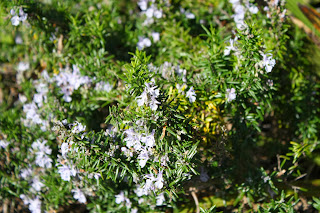 |
| Urtica ferox in Dunedin Botanic Garden |
Though generally a safe and hospitable land
in terms of predators and poisonous beasties, New Zealand is not entirely
devoid of floral hazards that can pack a punch. Case in point- Urtica ferox,
the native Tree Nettle or Onganonga. In the same genus as the UK’s own stinging
nettle (Urtica dioica), Ongaonga is New Zealand’s very own supercharged endemic
equivalent. It is easily distinguished from other members of its genus as its
growth habit is that of a woody shrub rather than a herb. The plant is widely distributed across both
the North and South Islands of New Zealand and can mainly be found growing in
areas of temperate bushland. Thickets of Ongaonga are not unknown and usually
occur in areas of sloped debris. An incredibly hardy plant, Ongaonga is able to
withstand temperatures as low as -80C.
Tree Nettle is dioecious, meaning that male
and female flowers occur on separate specimens of the plant. Small green flowers
borne on spikes up to 8cm in length grow from the leaf axis of the plant between
the months of November and March. Pollen from the male flowers is then
dispersed by the wind to their female counterparts, which following successful
pollination, develop into small, brown nut like fruits of one and half
millimetres in length.
 |
| Leaves of the mighty Ongaonga |
Perhaps the defining feature of the
Ongaonga in terms of human interaction with the plant is its incredibly
powerful and irritable sting. Stiff, hypodermic needle-like hairs adorn the plant’s flowers and branches
as well as the veins, stalks and edges of the deeply jagged leaves. Each hair is around 6mm
in length. When touched the hairs break and release a potent mixture of
intoxicants that can result in a host of painful and in very rare cases, deadly
reactions. Though rare, there have been accounts of dogs, horses and even one
very unfortunate walker meeting their maker at the hands of the Ongaonga’s
sting. Fortunately for the rest of us, a brush with the Ongaonga will generally
not result in death but rather a great deal of incredible discomfort lasting
somewhere in the region of three days. Indeed, the variety and intensity of the
symptoms brought on by the Ongaonga’s sting are quite remarkable (see table
below).
 |
| Yowza! |
Possible symptoms following contact with
Tree Nettle
Time after contact
|
Symptoms
|
Immediately
|
Painful, burning sensation
Numbness |
15-20 minutes
|
Abdominal cramps
Strong burning sensation in feet Visual blurring |
60–90 minutes
|
Weakness, exhaustion
Confusion Pale skin Sweating Salivating Cramps Breathing problems Loss of eye sight (!) Problems regulating body temperature Problems controlling movement of arms and legs |
However, the Ongaonga’s lack of hospitality
for the human race does not extend to all creatures. The Tree Nettle plays a
vital ecological role in the life cycle of the Red Admiral Butterfly (Vanessa gonerilla), another species endemic to New Zealand. The butterfly lays its
eggs amongst the spines of the Ongaonga’s leaves, which are the main food
source of the Red Admiral Caterpillar. The caterpillar also uses the plant as
protection from predators by folding the leaves around their bodies effectively
creating a makeshift tent. Fantastic!
Though eradicating the Tree Nettle would undoubtedly remove a potentially harmful element from our environment, the ecological implications for other inhabitants of our planet would be massive. Ongaonga is not just a plant, it is a home and nourishment for other species. Remember this if you are ever stung and your arms and legs start flailing wildy, your vision blurs and your body temperature begins to fluctuate. It may seem like a good idea to go back and exact horticultural vengeance but be mindful folks and look at the bigger picture.







































